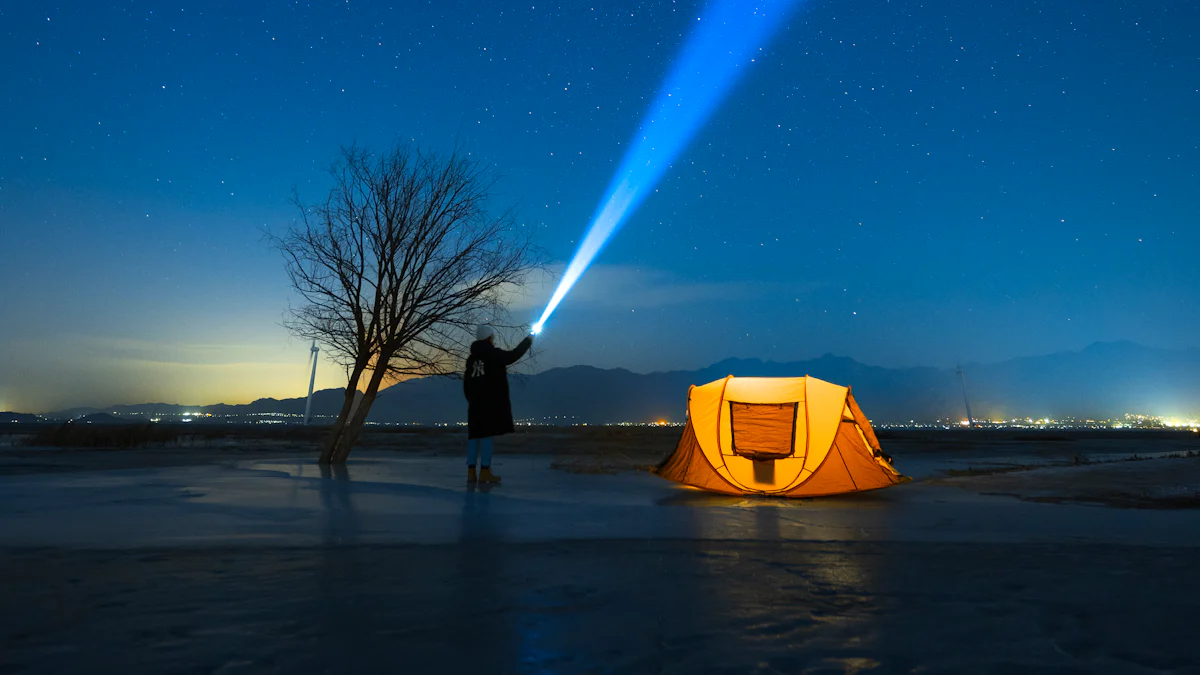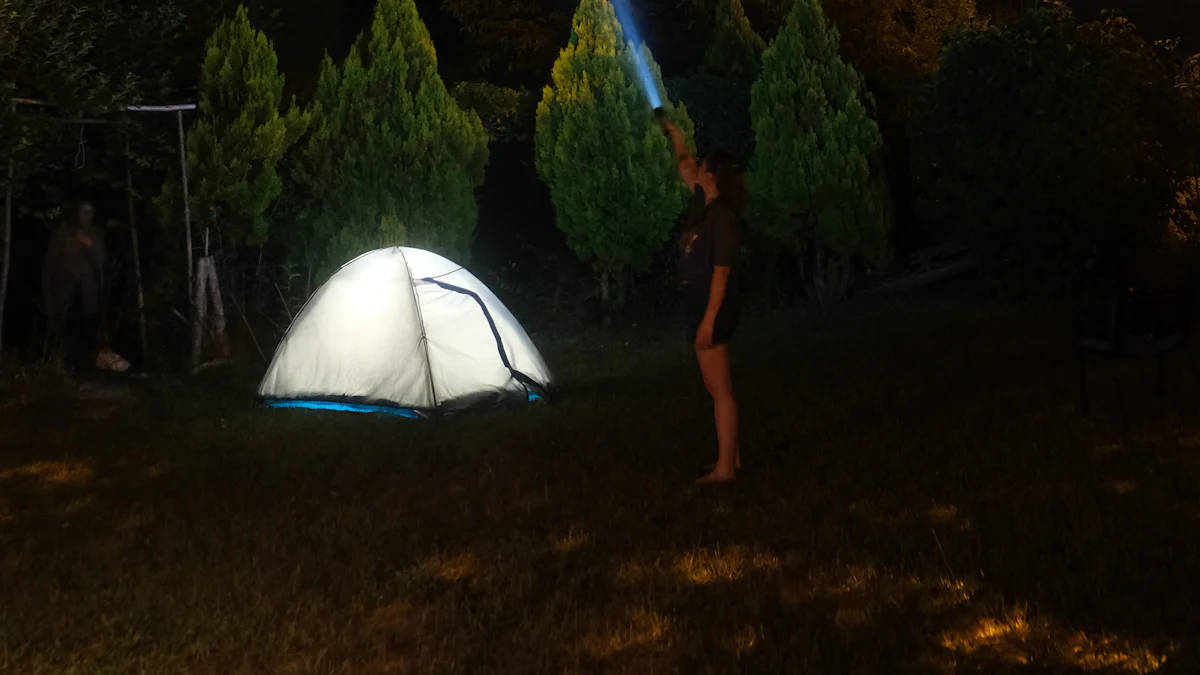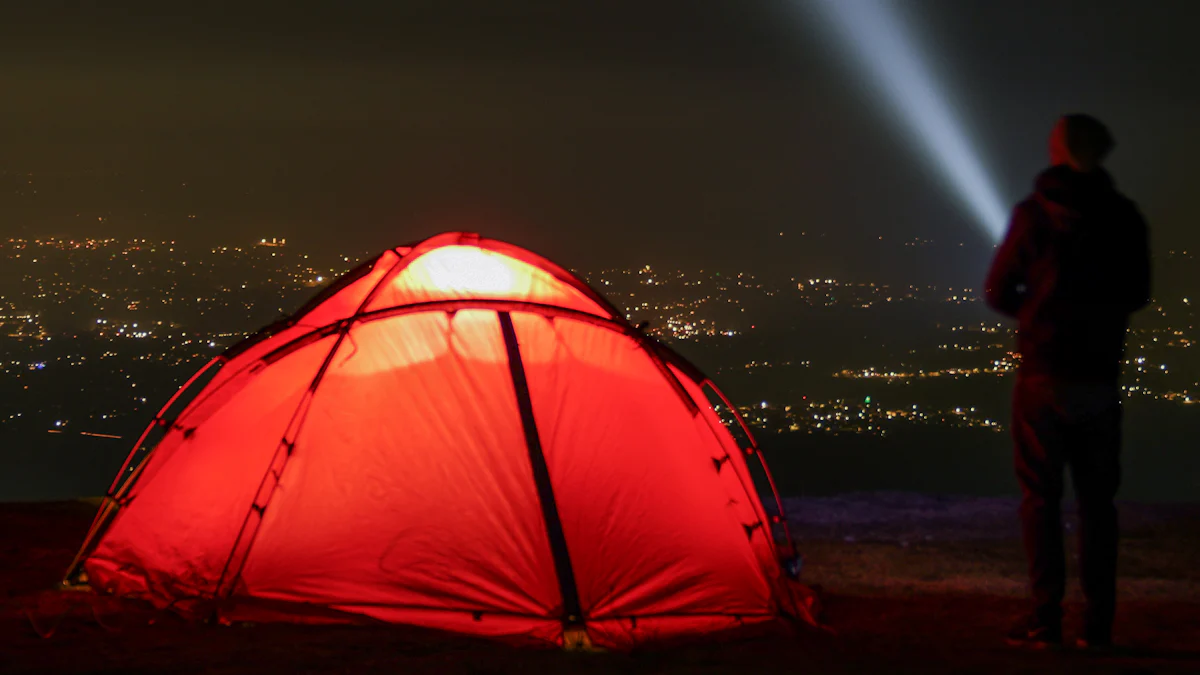Best flashlights for backpacking

When you're out on the trail, a reliable light can make all the difference. A good backpacking flashlight doesn’t just illuminate your path—it keeps you safe. It helps you avoid tripping over rocks or roots and ensures you can navigate after sunset. In emergencies, it can even signal for help. Features like waterproof designs and adjustable brightness levels make these tools indispensable for unpredictable conditions. Whether you're setting up camp in the dark or exploring a night trail, the right flashlight ensures you're always prepared.
Key Takeaways
A good flashlight is important for staying safe while hiking. It helps you see and avoid dangers in the dark.
Think about how bright the flashlight is before buying one. For most uses, 100-400 lumens works well. For night hikes, you may need 400-1000 lumens.
The weight of your gear matters when hiking. Pick a small, light flashlight to keep your backpack easy to carry.
Strong and waterproof flashlights are very important. Choose ones with high IP ratings so they can handle rough outdoor weather.
Rechargeable batteries are better for the environment and save money. They work well for long trips, but regular batteries are good backups.
Top Flashlight Recommendations for Backpacking

Lightweight and Compact Flashlights
Wurkos FC11 - Pros, Cons, and Key Features
If you're looking for a flashlight that's both lightweight and powerful, the Wurkos FC11 is a great option. It weighs just a few ounces, making it easy to carry without adding bulk to your pack. With a maximum brightness of 1,300 lumens, it’s bright enough for most backpacking needs. The USB rechargeable battery ensures convenience, especially for longer trips. However, it might feel slightly bulky compared to ultralight models.
Key Features:
Brightness: Up to 1,300 lumens
Battery: USB rechargeable
Weight: Approximately 4.4 oz
Pros:
High brightness for its size
Rechargeable battery
Durable aluminum body
Cons:
Slightly heavier than some compact options
Nitecore Thumb - Pros, Cons, and Key Features
The Nitecore Thumb is another excellent choice for ultralight backpackers. It weighs less than an ounce and features a tiltable head, making it versatile for tasks like reading or night hiking. The red light mode is a bonus for preserving night vision. However, its runtime is shorter compared to larger models.
Key Features:
Brightness: 150 lumens
Battery: USB rechargeable
Weight: 0.88 oz
Pros:
Extremely lightweight
Red light mode for night vision
Compact and easy to carry
Cons:
Limited runtime
High-Brightness Flashlights
Streamlight Protac HL5-X - Pros, Cons, and Key Features
For those who need serious brightness, the Streamlight Protac HL5-X delivers up to 3,500 lumens. It’s perfect for illuminating large areas or long-distance trails. The dual-fuel capability allows you to use either rechargeable or disposable batteries, offering flexibility. However, its size and weight make it less ideal for ultralight backpacking.
Key Features:
Brightness: Up to 3,500 lumens
Battery: Dual-fuel (rechargeable or disposable)
Weight: 1.2 lbs
Pros:
Exceptional brightness
Flexible battery options
Durable construction
Cons:
Heavy and bulky
Fenix PD36R - Pros, Cons, and Key Features
The Fenix PD36R strikes a balance between brightness and portability. It offers up to 1,600 lumens and a runtime of 115 hours on its lowest setting. Its compact design makes it one of the best for backpacking. The USB-C rechargeable battery adds convenience, but it lacks a red light mode.
Key Features:
Brightness: Up to 1,600 lumens
Battery: USB-C rechargeable
Weight: 3 oz
Pros:
Long runtime
Compact and lightweight
USB-C charging
Cons:
No red light mode
Durable and Waterproof Flashlights
ThruNite TC15 - Pros, Cons, and Key Features
The ThruNite TC15 is built to withstand tough conditions. Its IPX8 waterproof rating means it can handle heavy rain or even submersion. With a brightness of 2,300 lumens, it’s powerful enough for any adventure. However, its higher price point might not suit budget-conscious backpackers.
Key Features:
Brightness: Up to 2,300 lumens
Battery: USB rechargeable
Waterproof Rating: IPX8
Pros:
Excellent waterproofing
High brightness
Durable aluminum body
Cons:
Expensive
Fenix HM65R-T - Pros, Cons, and Key Features
The Fenix HM65R-T is a headlamp designed for durability and performance. It features dual light sources and an IP68 waterproof rating, making it ideal for wet conditions. Its lightweight magnesium body ensures comfort during extended use. However, it might feel less versatile compared to handheld options.
Key Features:
Brightness: Up to 1,400 lumens
Battery: USB rechargeable
Waterproof Rating: IP68
Pros:
Dual light sources
Lightweight and durable
Excellent waterproofing
Cons:
Limited to headlamp use
How to Choose the Best Flashlight for Backpacking
Key Factors to Consider
Brightness (Lumens)
When choosing a backpacking flashlight, brightness is one of the most important factors. Lumens measure how bright a flashlight is. For general hiking or camping, a flashlight with 100-400 lumens works well. If you’re night hiking or exploring caves, aim for 400-1000 lumens for better visibility. Flashlights in this range can illuminate distances up to 200 meters, keeping you safe in low-light conditions. For tasks like reading or cooking at camp, lower brightness (10-100 lumens) is more than enough.
Weight and Portability
Backpacking is all about minimizing weight. Ultralight flashlights are your best friend here. Compact models that weigh just a few ounces won’t weigh down your pack. Look for designs that balance portability with performance. A lightweight flashlight can make a big difference on long hikes.
Battery Type (Rechargeable vs. Disposable)
Your flashlight’s battery type can impact convenience. Rechargeable batteries are eco-friendly and cost-effective for frequent use. They’re ideal for longer trips if you carry a power bank. Disposable batteries, like AAA, are great backups. They’re easy to replace and don’t rely on charging options.
Durability and Waterproofing
Outdoor conditions can be unpredictable. A durable flashlight with a waterproof rating (like IPX8 or IP68) ensures it can handle rain or accidental drops in water. This feature is essential for reliability during your adventures.
Additional Features (e.g., multiple light modes, red light)
Extra features can enhance your flashlight’s usability. Multiple light modes, such as SOS or strobe, are helpful in emergencies. A red light mode preserves your night vision, making it perfect for stargazing or nighttime navigation. Hands-free options, like clips or straps, add convenience.
Matching Flashlights to Your Backpacking Needs
Short Trips vs. Long Expeditions
For short trips, a compact flashlight with 200-500 lumens and moderate battery life is sufficient. Long expeditions require more planning. Choose a flashlight with extended runtime and rechargeable batteries. Durability becomes even more critical for extended use in harsh conditions.
Solo Backpacking vs. Group Adventures
Solo backpackers often prioritize lightweight and compact flashlights for ease of carrying. Group adventurers might prefer larger, more powerful models to share among the group. Brightness and durability are key for both scenarios. For solo trips, a flashlight with multiple modes can be a lifesaver. In groups, a high-brightness flashlight ensures everyone stays safe and visible.
Comparing Flashlight Types for Backpacking

Handheld Flashlights vs. Headlamps
Pros and Cons of Handheld Flashlights
Handheld flashlights are a classic choice for backpackers. They’re compact, easy to carry, and provide powerful illumination. You can control the direction of the light, which is great for navigating dark trails or searching for items in your pack. Many models also come with adjustable focus and multiple brightness levels, giving you flexibility for different situations.
However, handheld flashlights can be less convenient when you need both hands free. Tasks like setting up a tent or cooking at night might feel tricky while holding a flashlight. Some models can also be heavier, which isn’t ideal for long backpacking trips.
Pros:
Powerful and versatile lighting
Adjustable focus and brightness options
Compact and easy to store
Cons:
Requires one hand to operate
Can feel heavy during extended use
Pros and Cons of Headlamps
Headlamps are a favorite among backpackers for their hands-free convenience. They keep the light focused wherever you look, making them perfect for nighttime activities like cooking or setting up camp. Lightweight and adjustable, headlamps are comfortable to wear for long periods.
On the downside, headlamps might not offer the same brightness or range as handheld flashlights. They’re also less versatile since they’re primarily designed for wearing on your head.
Pros:
Hands-free operation
Lightweight and comfortable
Ideal for nighttime tasks
Cons:
Limited brightness compared to handheld models
Less versatile for general use
Rechargeable vs. Disposable Batteries
Advantages of Rechargeable Batteries
Rechargeable batteries are a smart choice for frequent backpackers. They’re cheaper in the long run since you can recharge them multiple times. Plus, they’re more eco-friendly, reducing waste and the need for frequent recycling. Many rechargeable batteries are compatible with USB power banks, making them convenient for longer trips.
However, rechargeable batteries can be bulkier and require access to electricity for recharging. This might not always be practical in remote areas.
Advantages:
Cost-effective over time
Environmentally friendly
Convenient for frequent use
Advantages of Disposable Batteries
Disposable batteries are a reliable backup option. They’re easy to replace and don’t rely on charging equipment. This makes them ideal for emergencies or short trips. However, they have a shorter shelf life and can leak toxic chemicals if stored too long.
Advantages:
Easy to replace
Great for emergencies
No need for charging equipment
Multi-Use Flashlights (e.g., lanterns, hybrid models)
Benefits of Multi-Use Flashlights
Multi-use flashlights, like lanterns or hybrid models, are incredibly versatile. Lanterns spread light evenly, making them perfect for group activities like cooking or playing games at camp. They create a cozy ambiance and can brighten your entire campsite without being harsh on the eyes. Many models are rechargeable or solar-powered, which is both eco-friendly and convenient.
When to Choose a Multi-Use Flashlight
You should consider a multi-use flashlight for group trips or activities that require broader illumination. They’re also great for emergencies, road trips, or even night fishing. If you want one of the best camping flashlights for versatility, a hybrid model is a top pick.
Testing Methodology for Flashlight Recommendations
How Flashlights Were Tested
Real-World Backpacking Scenarios
To ensure each flashlight performs well in real-life conditions, we tested them on actual backpacking trips. These tests included night hikes, setting up camp in the dark, and navigating through dense forests. Brightness and beam distance were evaluated to see how effectively they illuminated trails and campsites. We also checked how easy it was to switch between light modes during activities like cooking or reading. This hands-on approach helped us identify the best camping flashlights for various outdoor needs.
Durability and Waterproofing Tests
Durability is critical when choosing a backpacking flashlight. To test this, we conducted drop tests by simulating accidental falls from heights of up to 10 feet. This ensured the flashlights could survive impacts without losing functionality. For waterproofing, we submerged them in water to verify their IPX ratings. Models with IPX7 and IPX8 ratings performed best, as they continued to work even after being fully submerged. These tests guarantee that the flashlights can handle tough outdoor conditions.
Battery Life and Brightness Measurements
Battery life and brightness are essential for any flashlight. Using tools like photometers and reflective boxes, we measured the lumens output over time. This helped us determine how long each flashlight could maintain its brightness on different settings. We also tested battery performance by running the flashlights continuously on their highest mode. Flashlights with rechargeable batteries were paired with power banks to simulate extended trips. These tests ensured you get the best overall performance for your adventures.
Criteria for Selecting the Best Flashlights
Performance in Outdoor Conditions
When you're out in the wild, your flashlight needs to deliver. Brightness and beam distance are crucial for safety and visibility. A flashlight with high lumens ensures you can see clearly, while durable construction keeps it functioning in rugged environments. Materials like aluminum or high-grade plastics provide strength and longevity. Additionally, environmental resistance is vital for handling extreme temperatures and humidity.
Value for Money
Finding the best for backpacking doesn’t mean breaking the bank. Look for flashlights that balance cost and quality. Mid-range options often offer excellent performance without the hefty price tag. Compare features like brightness, battery life, and durability across models. Trusted brands like Fenix and Streamlight are known for reliability. Reading user reviews can also help you gauge real-world performance. By matching features to your priorities, you can find a flashlight that’s worth every penny.
Choosing the right flashlight can make your backpacking trips safer and more enjoyable. Whether you prefer a lightweight option like the Nitecore Thumb or a durable model like the Fenix HM65R-T, there’s a perfect fit for your needs. Think about how you’ll use it. For short trips, go for compact and portable. For longer adventures, prioritize durability and battery life. The best backpacking flashlight balances brightness, weight, and reliability. Remember, the best camping flashlights don’t just light your way—they ensure you’re ready for anything the trail throws at you.
FAQ
What flashlight brightness is best for backpacking?
It depends on your trip. For general hiking, 100-400 lumens work well. Night hiking or cave exploration needs 400-1000 lumens. For camp tasks like reading, 10-100 lumens is enough. Choose brightness based on your activity.
How do I maintain my flashlight during a trip?
Keep it dry and clean. Store it in a protective case to avoid scratches. Check the battery regularly and recharge or replace it as needed. Always carry spare batteries or a power bank for emergencies.
Are rechargeable flashlights better than disposable ones?
Rechargeable flashlights are eco-friendly and cost-effective for frequent use. They’re great for long trips if you have a power bank. Disposable batteries are better for short trips or as backups since they don’t need charging.
Can I use a headlamp instead of a handheld flashlight?
Absolutely! Headlamps are perfect for hands-free tasks like cooking or setting up camp. They’re lightweight and convenient. However, handheld flashlights often provide more brightness and range, making them better for navigation.
What’s the most important feature in a backpacking flashlight?
Durability tops the list. Your flashlight should handle drops, rain, and tough conditions. Waterproofing, long battery life, and adjustable brightness are also key. A reliable flashlight ensures safety and convenience on the trail.
💡 Tip: Always test your flashlight before heading out to avoid surprises on the trail!
See Also
Essential Tips for Selecting the Best Hiking Flashlight
SF1 Camping Flashlight: Light Up Your Outdoor Experiences
Guidelines for Picking the Perfect Camping Flashlight
